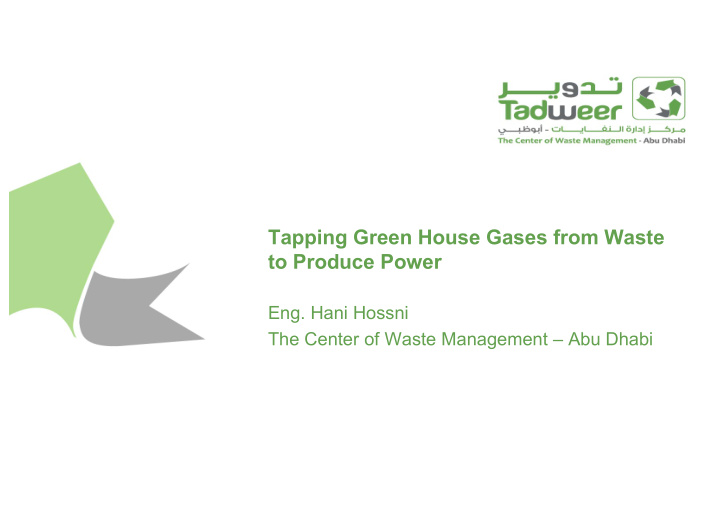



Tapping Green House Gases from Waste to Produce Power Eng. Hani Hossni The Center of Waste Management – Abu Dhabi
Eng. Hani Hossni • EHS Director in TADWEER since 2015 • OSHAD Executive Committee Member since 2013 • Former HSEQ Manager and Management Representative in ADDC / ADWEA. • Board Member in DQG, and Managing Director of EECT 2011. • Master in Quality Management from University of Wollongong in Dubai 2005. • Leads ADDC to Win SKEA 07, 11, and the 5 star from BSC in 09 • Recognized by Sheikh Ahmed bin Saeed Al Maktoum for the Young National Leader on the Excellence Business field, 09 • Sheikh Rashid Al Maktoum Award for Scientific Outstanding” 08
The Center of Waste Management – Abu Dhabi (TADWEER)
What is Landfill Gas (LFG)? • LFG is generated when organic materials in landfills are naturally decomposed by bacteria • LFG is roughly 50% methane with carbondioxide being the second most prevalent gas. • All solid waste landfills emit this gas in amounts that depend on a variety of factors, such as waste composition and landfill size.
Green House Gas Sources in Abu Dhabi Source: ADTR- GHG Emission Factors
Waste Composition in Abu Dhabi
Standards & Legislations
Determining if a Site is a Good Candidate for LFG Utilization Site Characteristics § Site Location § Landfill still receives waste (or is recently closed) § Landfill is near power grid or industry that could use the gas § Landfill has land available for alternative applications
Determining if a Site is a Good Candidate for LFG Utilization (cont.) Site Acceptance • Landfill gas utilization project is accepted by the local government and community Determining Methane Production Potential • Quantity of Waste in the Landfill – 1.2 million metric tons of waste in place • Waste Composition – Organics produce high quantities of methane
Determining if a Site is a Good Candidate for LFG Utilization (cont.) Management of Moisture in the Landfill • Leachate Management Landfill Stability Geology/ Hydrogeology • Lined landfill site • Unlined landfills produce higher methane generation if located in soils that have low permeability, such as clay • Temperature - methane production is maximized between 50-60 degrees Celsius
How is LFG Collected? • Landfill is sealed from above. i.e. by a layer of clay. • Gas collection wells are placed in the landfill. • Passive gas collection – uses natural variations in landfill gas pressure and concentrations (not considered very reliable) • Active gas collection – use of vacuum or pumps to move gas out of the landfill
Treatment of gas after collection • Combustion – open or closed flame flares, enclosed combustion which creates energy (boilers, process heaters, gas turbines, internal combustion engines) • Noncombustion – – Energy recovery technology – phosphoric acid fuel cell, other fuel cells are being developed. – Gas to product technologies – converting LFG into commercial products, (natural gas, methanol, purified CO2 or methane)
Landfill Before the Gas Capture
Landfill After the Gas Capture
Model - 1 Model - 2 REVENUE SHARING Green Energy Solution and Sustainability LLC has installed Under UNFCCC signatory countries like Norway, UK and other developed Landfill Gas Collection in Al Qusais Landfill of Dubai countries who have the obligations but are not able to achieve their target are financially supporting projects outside their country by purchasing Carbon Credit
The Process
From Pollutant to Electricity - The Use of Landfill Gas for Energy • From a landfill of about 850,000 sqm about 300,000 tons of landfill gas is expected and about 6 MW of electricity is expected to be generated • A landfill with 1 million tons of waste-in-place can typically support an 800 kilowatt (kW) to 1 MW electricity generation project • Costs to generate electricity from landfill gas typically range from 4 to 6 cents/kWh (for reciprocating engine projects).
Thank You
Recommend
More recommend